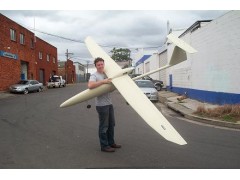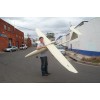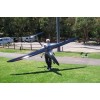While I was developing the EZI-NAV autopilot and the Digital Spread Spectrum RC system, I would make regular reports on there progress to Bob Young of Silvertone Electronics in Sydney, Australia. I would make these reports to Bob and he would tell me how much he would like to be here in Florida to participate in the development and the test flying. Well now it is Bob turn and I have to sit here in Florida and receive reports from him on how the development of a new UAV airframe called the Flamingo is progressing.
The Flamingo is a new all composite 4 meter UAV that Bob Young and John Haren have co-designed. Bob is a veteran radio control expert and developer of Silvertone Electronics radio control systems and RC frequency control keyboards. Bob has been keeping himself busy building special radio control systems for movie and robotics industry. Recently a client sought help with a UAV project for special applications of inspecting large sheep and cattle stations in the Australian Outback without physically making the trip. The remote controlled / autonomous aircraft is flown from base to the remote location and the inspection is made by on-board television cameras.
Bob sought the help of his long time friend John Haren in designing an aircraft suitable for the task and this is how the Flamingo UAV came to life.
To start with the Flamingo in not a small UAV it's a 4 meter wingspan single boom pusher design with an aspect ratio of 13.7:1, Basically it's a really big powered glider. It will use the EZI-NAV autopilot system for autonomous navigation and altitude hold.
The Flamingo is an all composite airframe built from Fiberglass, Carbon Fiber and Foam. The wings are built using three laminated layers over a foam core, two layers of fiberglass with a layer of 2.5 mm balsa sheeting between them for a very strong but light wing.
The wing is a 15% thick NACA 2415 section at the wing root, tapering off as the wing progresses towards the tips and the load decreases. In one of the photos you can see a test of the strength of the wing - it is amazingly strong - it took 100kg (220.46 lb) of bricks to break the wing, and that load also broke the table! In the photographs it can be clearly seen in that the table is giving away before the wing.
John Haren has put hours of design work in to the Flamingo UAV project. He conducted an analysis of the wing planform, investigating the local Reynold's Numbers at each chord position using XFOIL. The result was a modification to the outboard airfoils to reduce drag at low Reynold's Numbers, while also considering stall characteristics.
John also calculated the strength of the wing using engineering principles. Originally a complicated carbon spar systems were considered, but Bob thought that the wing skins would carry the load - and he was right - this was confirmed by the load test (see photo page).
Though the wing and tail are conventional laminated fiberglass and balsa over a foam core. Most of the fuselage is molded from fiberglass. A Queensland company, Daybreak Industries, has been laser cutting profiles from dense craftwood (Craftwood is a very fine particle board) used to create the plugs for moldings the fuselage sections, you can see the multiple sections cut and assembled to create the fuselage centre section in the photos on the photograph page. Again, John spent hours on the fuselage design, and the final version was V.5.0.
Bob has handled most of the construction phase, with well-known glider identity, Bjorn Rudgely handling all the fuselage moldings work. Bjorn created the moulds and laid up the finished product. You can see Bjorn in a photograph holding the "Not so small" Flamingo Airframe.
Australia host the World Solar Challenge it is a race for solar powered Vehicles. The race starts from Darwin at the top of Australia and ends over 3,000km away in Adelaide at the bottom Australia.
All types of solar powered vehicles participate in the race.
There is talk of flying an all electric powered Flamingo to shoot video of the solar-powered vehicles throughout the race.
It would be a great promotion for electric-powered flight and the Flamingo if it comes off.
Even though Bob has been the driving force behind the Flamingo no one person can be given or take the full credit for such a project. It takes a team of dedicated people to make it happen and that's how it has been at Silvertone Electronics. The SE team has devoted many many long hours of hard work and intense dedication into making Project Flamingo a reality.






